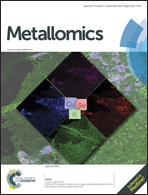Hepcidin quantification: methods and utility in diagnosis
Abstract
Hepcidin is a 25-amino acid peptide hormone that is produced and secreted predominantly by hepatocytes, circulates in the bloodstream, and is excreted by the kidneys. Since the discovery of hepcidin and the elucidation of its important role in iron homeostasis, hepcidin has been suggested as a promising diagnostic marker for iron-related disorders. In this regard, a number of analytical methods have been developed in order to assess hepcidin concentration in different biological fluids, particularly serum and urine. In this critical review we have tried to address the issues still pending in accurate determination of this peptide by evaluating the available analytical methodologies. Among them, the use of ELISA strategies (in competitive or sandwich formats) and molecular mass spectrometry (MS) including MALDI and/or LC-MS has been critically compared. The use of elemental mass spectrometry (ICP-MS) has also been included as a possible complementary tool to the previous ones. In addition, this manuscript has revised the existing and potentially emerging clinical applications of hepcidin testing for diagnosis. These include the iron disorders such as iron deficiency anemia (IDA, low hepcidin), anemia of chronic disease (ACD, high hepcidin) and the combined state of ACD and IDA or hemochromatosis. Other applications such as using hepcidin in assessing the response to existing therapies in cancer have also been revised in the manuscript.


 Please wait while we load your content...
Please wait while we load your content...